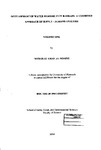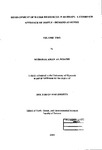DEVELOPMENT OF WATER RESOURCES IN BAHRAIN: A COMBINED APPROACH OF SUPPLY-DEMAND ANALYSIS
| dc.contributor.author | AL-NOAIMI, MUBARAK AMAN | |
| dc.contributor.other | Faculty of Science and Engineering | en_US |
| dc.date.accessioned | 2013-09-25T08:56:18Z | |
| dc.date.available | 2013-09-25T08:56:18Z | |
| dc.date.issued | 2004 | |
| dc.identifier | NOT AVAILABLE | en_US |
| dc.identifier.uri | http://hdl.handle.net/10026.1/1951 | |
| dc.description.abstract |
Bahrain is an arid country with acute water shortage problems. The demand for water has increased substantially over the last four decades, leading to over-exploitation from the already scarce renewable groundwater resources. This has caused a significant decline in groundwater levels, a drastic storage depletion, and serious deterioration in groundwater quality. The imbalance between the available water supply and the projected water demand has been growing rapidly, imposing a major constraint on the country's socio-economic development. Resolving these problems or at least mitigating their adverse impacts primarily requires a major shift from the supply-oriented approach to water planning, which is currently being emphasised, towards a greater emphasis on demand-side management policies. In this thesis, a combined approach of supply-demand analysis is employed to investigate the water and management problems in the study area, with the ultimate objective of establishing a supply-demand analytical framework to aid in the formulation of an integrated water management policy. The existing water resources are comprehensively assessed in terms of availability and development constraints. The water use patterns and demand characteristics are systematically analysed. The results of these analyses are shown to have important implications from the water resources planning and management perspective. Using data from cross-sectional surveys, separate water demand functions of both linear and log-linear functional forms are estimated for the major water use activities. The empirical evidence presented in this research suggests that certain socio-economic, demographic, physical, climatic, and technological factors affect water use. The variables household size and household/per capita income are found to be the most important determinants of residential water use, with a priori expected signs. Average price, however, does not have a statistically significant effect. Estimated income elasticities vary from 0.12 to 0.22; household size elasticities range from 0.30 to 0.41. Empirical estimates for summer and winter residential demand functions suggest some interesting findings with respect to the seasonal variability in water use. Per capita income elasticities of municipal demand of between 0.15 - 0.33 are estimated. Both the residential and municipal income elasticity estimates appear to correlate favourably with some estimates found in the literature. Not surprisingly, average price elasticity of per capita municipal demand is estimated to be -0.066, indicating an extremely inelastic demand. In general, the empirical findings from both the non-residential and agricultural surveys give less reliable statistical results, perhaps owing to the insufficiency of data and/or lack of specific explanatory variables. However, the variables number of bathrooms and presence of swimming pool may be adequate indicators of the non-residential water use, while gross cultivated area appears to be the best single predictor of the agricultural water use. Industrial water demand is shown to be significantly and directly related to the variables measuring production level, number of employees, and factory floor area. Validity tests for the selected analytical models are made. The water supply and demand relationships are examined and water balances for the specified planning period are computed. The improved trend forecasting procedures provide encouragingly accurate results when compared to the actual water use. Three alternative water management scenarios are developed. Comparison among these scenarios indicates that Scenario C, which integrates the supply and demand management policies, is the most efficient option for achieving optimal water resources development and management. Policy recommendations to enable effective formulation and implementation of this option are presented. | en_US |
| dc.language.iso | en | en_US |
| dc.publisher | University of Plymouth | en_US |
| dc.title | DEVELOPMENT OF WATER RESOURCES IN BAHRAIN: A COMBINED APPROACH OF SUPPLY-DEMAND ANALYSIS | en_US |
| dc.type | Thesis | |
| plymouth.version | Full version | en_US |
| dc.identifier.doi | http://dx.doi.org/10.24382/3414 |
Files in this item
This item appears in the following Collection(s)
-
01 Research Theses Main Collection
Research Theses Main



